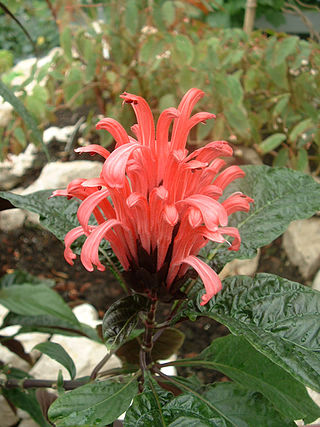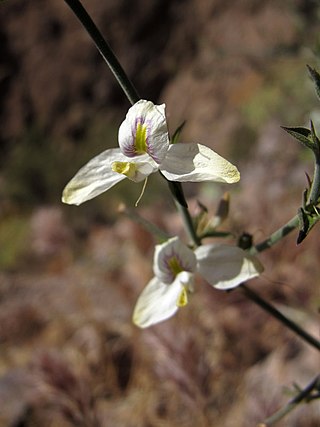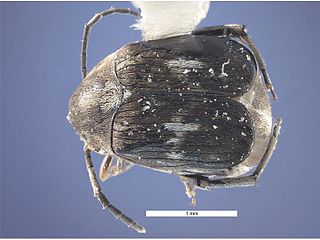
Justicia brandegeeana, the Mexican shrimp plant, shrimp plant or false hop, is an evergreen shrub in the genus Justicia of the acanthus family Acanthaceae, native to Mexico, and also naturalized in Florida.

Acanthaceae is a family of dicotyledonous flowering plants containing almost 250 genera and about 2500 species. Most are tropical herbs, shrubs, or twining vines; some are epiphytes. Only a few species are distributed in temperate regions. The four main centres of distribution are Indonesia and Malaysia, Africa, Brazil, and Central America. Representatives of the family can be found in nearly every habitat, including dense or open forests, scrublands, wet fields and valleys, sea coast and marine areas, swamps, and mangrove forests.

Justicia is a genus of flowering plants in the family Acanthaceae. It is the largest genus within the family, encompassing around 700 species with hundreds more as yet unresolved. They are native to tropical to warm temperate regions of the Americas, India, and Africa. The genus serves as host to many butterfly species, such as Anartia fatima. Common names include water-willow and shrimp plant, the latter from the inflorescences, which resemble a shrimp in some species. The generic name honours Scottish horticulturist James Justice (1698–1763). They are closely related to Pachystachys.

Barleria is a genus of plants in the family Acanthaceae. It includes 303 species native to the tropics and subtropics, including the Americas from Mexico to northern South America, sub-Saharan Africa, Egypt and the Arabian Peninsula, the Indian subcontinent, Indochina, southern China and Taiwan, parts of Malesia, and New Guinea.
Thomandersia is the sole genus in the Thomandersiaceae, an African family of flowering plants. Thomandersia is a genus of shrubs and small trees, with six species native to Central and West Africa.
Acanthopale is a plant genus of shrubs or subshrubs in the Acanthaceae plant family. The genus name is based on the classic Greek words for thorn ákantha and stake palum. Some species in the genus are cultivated as ornamental plants.
Blepharis dhofarensis is a species of plant in the family Acanthaceae. It is a shrub that grows to around 5m tall and is found in Oman and Yemen. Blepharis dhofarensis grows on wet escarpment woodlands and it prefers dense thickets on steep slopes. It is threatened by habitat loss. Recent molecular work has placed it in the genus Acanthus instead of Blepharis.

Carlowrightia is a genus of flowering plants in the bear's breeches family, Acanthaceae. Members of the genus, commonly known as wrightworts, are mainly small shrubs bearing inflorescences of lily-like flowers. They are native to the Americas, with many species found in western North America. The genus was named for the American botanist Charles Wright.

Hofmeisteria is a genus of Mexican flowering plants in the family Asteraceae.

Microtia is a monophyletic genus of butterflies from southern United States and Central America in the family Nymphalidae. It contains the single species Microtia elva, the elf. Larvae of this species feed on Tetramerium and other species in the family Acanthaceae.
Cornelis Eliza Bertus Bremekamp was a Dutch botanist.

Vallesia is a genus of plants in the family Apocynaceae first described as a genus in 1794. It is native to South America, Central America, Mexico, Florida, Galápagos, and the West Indies.

Bravaisia is a genus of plants in the family Acanthaceae. It includes three species of shrubs or trees native to Mexico, Central America, Colombia, Venezuela, Cuba, and Trinidad.
Thomas Franklin Daniel is an American botanist, and teacher. He is a specialist of the botanical family Acanthaceae. In 1975 he obtained his undergraduate from Duke University. In 1980, he obtained his doctorate at the University of Michigan. In 1981, he was assistant professor. Between 1981 and 1985 he was an assistant curator of the Arizona State University Herbarium.

Zabrotes is a genus of pea and bean weevils in the beetle family Chrysomelidae. There are more than 20 described species in Zabrotes.

Yeatesia is a putative genus of flowering plants in the family Acanthaceae, found in northeast Mexico and the southeast United States, from Texas to Florida. Each of its species grows in very different habitats; Yeatesia mabryi is found in hardwood forests in Mexico, Y. platystegia prefers semiarid scrublands in Mexico and Texas, and Y. viridiflora grows in wetter forest bluffs and along water courses in US Gulf Coast states. Molecular evidence shows that Yeatesia is not a monophyletic genus.
Chalarothyrsus is a genus of flowering plants belonging to the family Acanthaceae.
Chileranthemum is a genus of flowering plants belonging to the family Acanthaceae.
Mexacanthus is a genus of flowering plants belonging to the family Acanthaceae.
Streblacanthus is a genus of flowering plants belonging to the family Acanthaceae.










